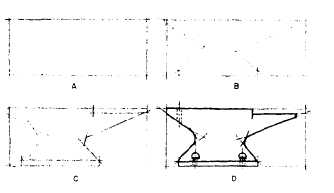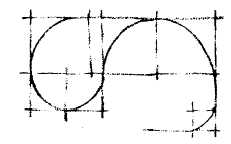which must be made heavier. Do this as shown
in view B. Notice that you DO NOT PIVOT on
the second finger during this step. You rest your
hand on its side and, keeping it within the circle,
trace over the light line with your hand pivoting
naturally at the wrist. As you work around the
circle in this way, rotate the paper counter-
clockwise so that your hand can work in its most
natural and easy position. Of course with smaller
circles you cannot work with your hand within
the circle, but the same general approach can be
used with success.
Probably one of the best methods to sketch
curves connected to straight lines is the six-step
method illustrated and explained below.
1. Intersect a vertical and
horizontal line, lightly.
2. Mark off on the horizontal
and vertical lines the same distance
from the intersection.
3. Draw a light diagonal line
through the two points marked.
4. Place an x or a dot in the
exact center of the triangle formed.
5. Start your curve from one
point of the triangle preferably on
the vertical line) touching the x or
dot and ending at the other point of
the triangle.
6. Erase all unnecessary guide-
lines and darken the curve and
necessary adjoining straight lines.
A little practice with this method should enable
you to improve your ability to sketch curves
properly.
Figure 5-66 shows a convenient way to sketch
arcs and curves by lightly drawing construction
boxes (or blocks).
Figure 5-66.-Sketchirrg curves using construction
boxes.
Construction Lines
When you are sketching an object, such as that
shown in figure 5-67, don’t start at one corner
and draw it detail by detail and expect it
come out with the various elements in correct
proportion. It is better to block in the overall size
of the object first, (See fig. 5-67, view A.) Then
draw light guidelines at the correct angles for the
various outlines of the object. (See fig. 5-67, views
B and C.)
Finish the sketch by first making an outline
of the object and then drawing in the details, as
shown in figure 5-67, view D.
Order of Sketching
To make a working sketch, first choose a clean
sheet of paper, either plain or ruled. Estimate the
size the sketch should be, and select the views that
will give the best picture of the object. Then draw
the ORTHOGRAPHIC PROJECTIONS of these
views, leaving adequate space between them for
Figure 5-67.-The use of construction lines in sketching an
object.
5-33





